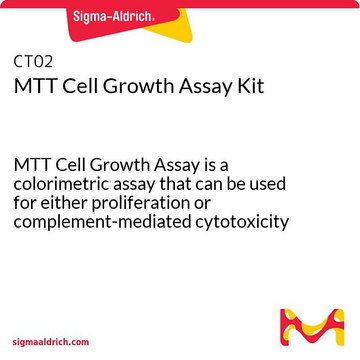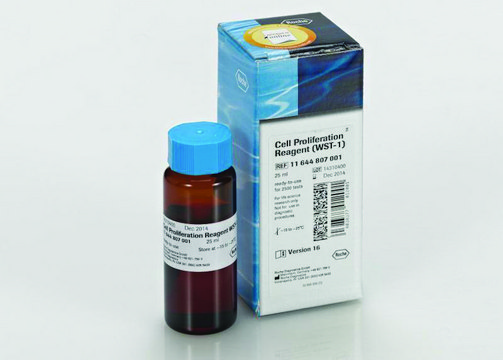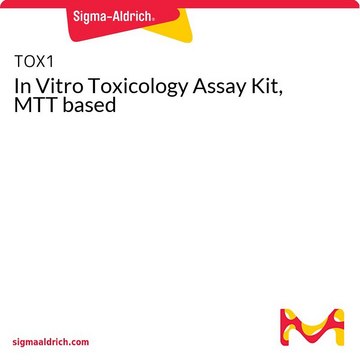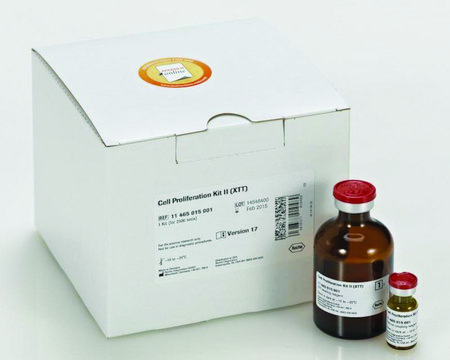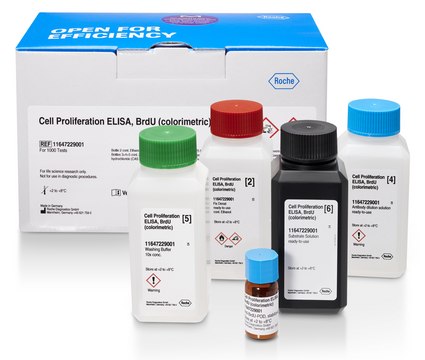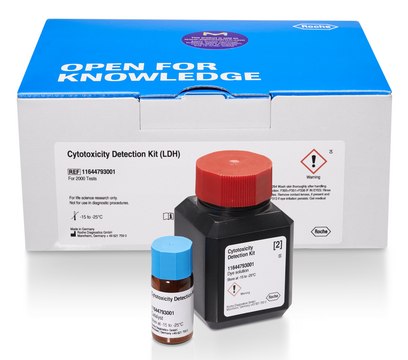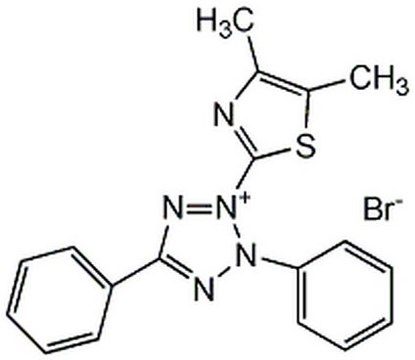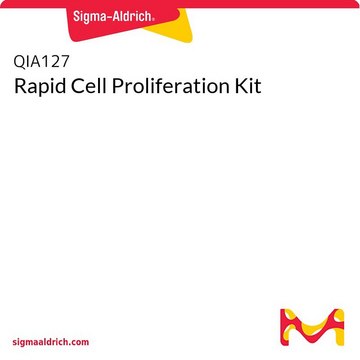추천 제품
양식
liquid
Quality Level
사용
sufficient for ≤2,500 tests
포장
pkg of 1 kit
제조업체/상표
Roche
저장 조건
protect from light
기술
tissue culture: suitable
λmax
550-600 nm
응용 분야
cell analysis
detection
검출 방법
colorimetric
저장 온도
−20°C
일반 설명
The Cell Proliferation Kit I (MTT) is a colorimetric assay for the nonradioactive quantification of cellular proliferation, viability, and cytotoxicity. Sample material is either adherent or suspension cells cultured in 96-well microplates.
Colorimetric assays analyze the number of viable cells by the cleavage of tetrazolium salts added to the culture medium. This technique requires neither washing nor harvesting of cells, and the complete assay, from microculture to data analysis by an ELISA reader, is performed in the same microplate.
MTT was the first tetrazolium salt described. It is cleaved to formazan by enzymes of the endoplasmic reticulum. This bioreduction occurs in viable cells only, and is related to NAD(P)H production through glycolysis. Therefore, the amount of formazan dye formed directly correlates to the number of metabolically active cells in the culture.
Colorimetric assay (MTT based) for the nonradioactive quantification of cellular proliferation, viability, and cytotoxicity.
Colorimetric assays analyze the number of viable cells by the cleavage of tetrazolium salts added to the culture medium. This technique requires neither washing nor harvesting of cells, and the complete assay, from microculture to data analysis by an ELISA reader, is performed in the same microplate.
MTT was the first tetrazolium salt described. It is cleaved to formazan by enzymes of the endoplasmic reticulum. This bioreduction occurs in viable cells only, and is related to NAD(P)H production through glycolysis. Therefore, the amount of formazan dye formed directly correlates to the number of metabolically active cells in the culture.
Colorimetric assay (MTT based) for the nonradioactive quantification of cellular proliferation, viability, and cytotoxicity.
애플리케이션
The Cell Proliferation Kit I (MTT) is used for the nonradioactive, spectrophotometric quantification of cell proliferation and viability in cell populations using the 96-well-plate format. It can be used for:
- Measurement of cell proliferation in response to growth factors, cytokines, mitogens, and nutrients
- Analysis of cytotoxic and cytostatic compounds, such as anti-cancer drugs and other pharmaceutical compounds
- Assessment of growth-inhibitory antibodies and physiological mediators
- Testing of biocompatibility of various scaffolds, employed in bone tissue engineering, for bone cell growth
특징 및 장점
- Safe and easy: Eliminate radioactive isotopes, washing steps, and additional reagents.
- Accurate: The absorbance obtained strongly correlates to the cell number.
- Sensitive: Detect low cell numbers.
- Fast: Process a large number of samples using a multi-well ELISA reader.
The assay is based on the cleavage of the tetrazolium salt MTT in the presence of an electron-coupling reagent. The water-insoluble formazan salt produced must be solubilized in an additional step. Cells grown in a 96-well tissue culture plate are incubated with the MTT solution for approximately 4 hours. After this incubation period, a water-insoluble formazan dye is formed. After solubilization, the formazan dye is quantitated using a scanning multi-well spectrophotometer (ELISA reader). The measured absorbance directly correlates to the number of viable cells.
Cell proliferation and viability assays are of particular importance for routine applications in cell biology. Tetrazolium salts (e.g., MTT, XTT, WST-1) are particularly useful for this type of analysis. Tetrazolium salts are cleaved to formazan by the succinate-tetrazolium reductase system (EC 1.3.99.1) which belongs to the respiratory chain of the mitochondria, and is only active in metabolically intact cells (see below).
Cell proliferation and viability assays are of particular importance for routine applications in cell biology. Tetrazolium salts (e.g., MTT, XTT, WST-1) are particularly useful for this type of analysis. Tetrazolium salts are cleaved to formazan by the succinate-tetrazolium reductase system (EC 1.3.99.1) which belongs to the respiratory chain of the mitochondria, and is only active in metabolically intact cells (see below).
포장
1 kit containing 2 components.
제조 메모
Storage conditions (working solution): 2 to 8 °C
After thawing, the MTT labeling reagents may be stored protected from light at 2 to 8 °C for up to 4 weeks, in which case reagent filtration through a 0.2 μm pore size membrane is recommended.
After thawing, the MTT labeling reagents may be stored protected from light at 2 to 8 °C for up to 4 weeks, in which case reagent filtration through a 0.2 μm pore size membrane is recommended.
키트 구성품 전용
제품 번호
설명
- MTT Labeling Reagent
- Solubilization Solution
Storage Class Code
12 - Non Combustible Liquids
WGK
WGK 2
Flash Point (°F)
does not flash
Flash Point (°C)
does not flash
이미 열람한 고객
자사의 과학자팀은 생명 과학, 재료 과학, 화학 합성, 크로마토그래피, 분석 및 기타 많은 영역을 포함한 모든 과학 분야에 경험이 있습니다..
고객지원팀으로 연락바랍니다.
